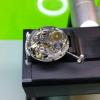-
Recently Browsing
- No registered users viewing this page.
-
Topics
-
Posts
-
By Neverenoughwatches · Posted
Ah so its you thats buying up all the DD calibres 🤨. -
Hi Richard, I keep buying CAL.59 movements to practice on 🙂 Not started yet though, I'm gathering tools and building my confidence to start.
-
Problem solved. For some bizarre reason, the hook on the wall of this barrel is not properly centered vertically, but is oddly high on the wall, maybe 3/4 up the way up. When replacing the mainspring, this caused the outer coil to be displaced upwards as well such that it protrudes out of the barrel and caused the barrel lid to not sit quite flush to the barrel. Since this is a motor barrel, the lid is actually the first wheel and inner coil tube/hook all in one piece, with no “snap down” action that would have made the problem more immediately obvious. Maybe with an older mainspring the spring’s end hole was enlarged such that this wasn’t an issue, but hard to say how it ever worked otherwise. Replacing the barrel with one from a different model 1900 where the hook was properly vertically centered allowed the lid to sit flush without mainspring interference and the friction problem went away. The bridge was far too thick to be bent (and isn’t), for those of you thinking that was the problem. Placing the removable arbor in the watch without the rest of the barrel proved that the proper end shake was actually there as long as the overall height of the assembled barrel was correct.
-
You are so true on a lot of what you have said. The main reason for changing the mainspring even if the old one is in good order is because it will take out your thinking that the mainspring is contributing to poor power output or fluctuations in amplitude. If a new spring is fitted that box can be crossed off as a potential source of a problem. Most customers are happy to pay the extra £20 for a new mainspring if they are already parting with a couple of hundred pounds for a service. A new spring is an investment for good running for the future.
-
By nickelsilver · Posted
According to Borel the 814 and 815 use the same escape wheel. It's kind of an oddball being so long.
-







Recommended Posts
Join the conversation
You can post now and register later. If you have an account, sign in now to post with your account.
Note: Your post will require moderator approval before it will be visible.